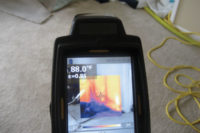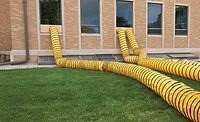Fire and Ice: A Case Study

On Jan. 12, the venerable Belcher Mansion, a sprawling three-story, 120-year-old Victorian-style home in Stoughton, Mass. was ablaze. Flames shot through multiple levels of the multi-pitched rooftop.
A neighbor saw the flames and warned the occupants; everyone escaped unharmed. Dozens of firefighters from surrounding communities fought the blaze as flames spread through the three-story dwelling. After several hours of hard work and thousands of gallons of water, the blaze was extinguished, leaving the house charred and smelling of soot as steam rose from the smoldering embers.
That night the temperature dropped to 16 F, and remained below freezing for days. The water used to extinguish the fire quickly turned to ice. ARS Services, a New England restoration company, was called to remediate the loss. The insurance claims department requested we assist ARS and develop a plan for drying the beautifully crafted wood stairway and entrance area that is the “crown jewel” of the property.
On arrival, the three-story staircase was encased in ice and no heat or electricity was available in the structure. If the staircase was to be saved, heat would be needed, along with the ability to direct the heat to the ice (soon to be water) without causing condensation in other areas of the home.
Drying the winding wooden structure would be complicated and directed heat drying was the answer. ARS called Dick Fox, CR, who had the closest self-contained trailer-mounted Thermal Energy System, or TES. Thus began the process that ultimately saved the handcrafted work-of-art in the historically significant property. The team had to deal with a variety of special criteria. There were requirements related to saving the stairway and its intricate architectural detail, while the vagaries of the outside cold New England winter played havoc: cold during the day, frigid during the night. The insurer and insured had concerns for saving the beautifully built masterpiece. The staircase had been meticulously thought out, with each piece of carved wood adding a new detail to the piece to which it was attached.
After observing how the staircase was assembled, an enclosure was created around the stairwell and entry foyer; the empty cavity within the stairwell would be used to direct the heat to the water.
A carpenter carefully removed the lowest back panel of the wooden staircase. A TES system was inserted and the opening sealed. The width of the cavity was small when compared to the length dimension; in this cavity heat would transfer from lower to higher areas due to a combination of conduction, convection and radiation. The stairwell being dried was a “finite cavity.” Directing heat inside the cavity caused the moisture in the wood to increase in temperature, changing it from ice to water to, finally, vapor as the energy increased over a short period of time. Changing the state of water molecules requires energy, and directing the energy to the water was by far the most efficient method.

In the confines of the stair cavity, local eddies developed. When observed with an anemometer, the eddies of moisture were circular and symmetric, due to being trapped by the risers and treads. Positive pressure inside the space forced the moisture air out through small joints and gaps.
Water, like all fluids, moves under the influence of pressure differences; however, suction also becomes an important ally. When a water molecule touches a pore wall, adhesion to the pore wall slows the rate of movement (depending on the diameter of the pore). Adhesion, or permeance, causes friction to slow the rate of moisture transfer or what is often called “evaporation.”
Water molecules have surface tension, and surface tension for water molecules in contact with air decreases with temperature. Pressure differentials in wood, like most materials restorers dry, has a permeance rating based in part on capillarity. Capillarity occurs whenever a gas, a liquid and a material contact each other. With the wooden pores filled with water and air, capillary action originates due to adhesion between the water molecule and the pore wall.
Wood has a sufficiently small diameter pore size, allowing water molecules to form concave surfaces that “pull” the water creating capillarity. The very nature of heating the water molecule reduces the surface tension, allowing accelerated drying to occur. Utilizing directed heat allowed us to maintain the surface temperature above the condensation zone.

Drying the wooden staircase successfully occurred because the relative humidity in the drying chamber dropped below the relativity in the pores of the wood and at its surface. Moreover, the drying time decreased because we increased the heat energy in the chamber and directed it to the water molecules. The higher the temperature (within reason) the lower the relative humidity. Add higher air velocity air movement, as was done in the enclosed stair space, and drying times are minimized.
Most people apply this principle without knowing it. For instance, wet laundry is placed in a confined clothes dryer (clothes dryer = high temperature). Add dry air (low relative humidity) and air movement (more velocity) and the wet laundry dries fast.
The drying situation decreased moisture at the wet surface. As a consequence, a moisture content gradient initiated moisture movement. Thus the capillary moisture flow increased until the moisture transfer became vapor only, and drying was completed. The dry goal was reached and the stairway and its wooden entry foyer were returned to pre-loss condition.
The stairway was “dry” in less than one week, when the wood regained hygroscopic equilibrium. It may take several more weeks to fully acclimate to its environment. When this occurs, craftsmen will be able to start the process of refinishing the masterpiece to its original splendor. All too often, the surface looks dry, well-meaning contractors start the refinishing process too soon, and problems arise.
Drying with heat is not new, and drying with refrigerant dehumidifiers has been with us since industry pioneers recognized that the concepts developed by W. H. Carrier (1876- 1950), the “father” of air conditioning and the first to publish a psychrometric chart, had applications to drying wet materials.
The “quality” of dehumidification is determined by its potential to evaporate and condense moisture. With heat, higher temperature means higher quality, which means higher energy of molecules. The quality of heat is determined by its potential and directing the energy to the water: adding temperature, which in turn means higher mechanical energy of atoms in wet material.
Higher temperatures are obtained when restorers warm up the water molecule, i.e., by adding heat. Lower temperatures are obtained by cooling down the water molecule, i.e., by removing heat.
Why was heat so important in drying this stairwell? The design and construction of the staircase and the constraints of the job site dictated directed heat drying was the right tool for the job. The team implemented the technology skillfully, and took great pride in bringing the damaged masterpiece back to life.
Looking for a reprint of this article?
From high-res PDFs to custom plaques, order your copy today!




